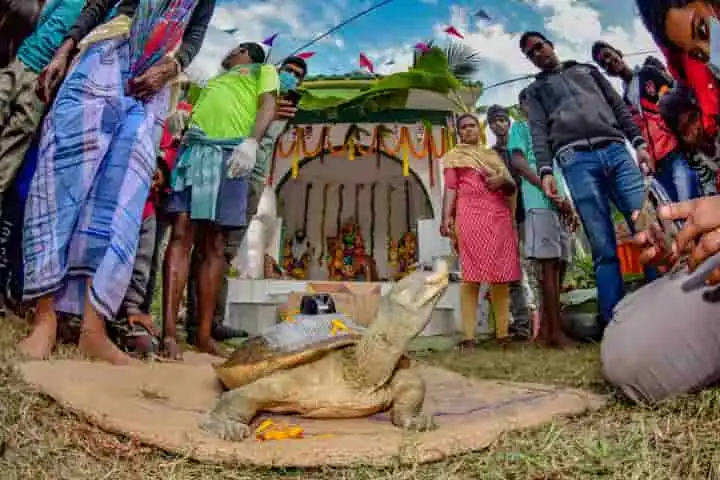In what can be described as a major achievement, 10 northern river terrapin turtles (Batagur baska), categorised as one of the most critically endangered species in the world by the International Union for Conservation of Nature, were released in the wild at the Sunderbans in West Bengal. They were fitted with GPS transmitters to enable scientists to monitor their movements, gather information about their habitat and home range and aid in their future releases.
Before their release the turtles were blessed by Bonbibi, the local diety.

The 10 reptiles – seven females and three males — were reared in Sunderbans breeding centre under a programme started by the Sundarbans Tiger Reserve authorities and the Turtle Survival Alliance at Sajnekhali in 2009. Following this initiative, the first batch of around 33 hatchlings were produced in three years.
Talking to The Hindu, Shailendra Singh, Director of TSA India said: “These animals were tagged with GPS transmitters the battery of which can last 18 months. These transmitters will help to understand survival and dispersal patterns of the turtles and adjust future large scale release programs. This will help to generate the basic ecological data on the conservation requirements of released animals.”
The Prague Zoo showcased the batagur baska turtles, among the rarest species of turtles in the world. The zoo said it is the only place outside Asia where the public can see the reptiles 🐢 pic.twitter.com/e4f6tUgsa5
— Reuters (@Reuters) August 6, 2021
Sharing details about the GPS tagging, Dr. Singh said it was the first ever done for tracking of any freshwater turtle in India. It is expected that this will pave the way for more such exercises for other threatened turtles species in the country.
Justin Jones, the Deputy Field Director told The Hindu: “We have no data on the habitat of Batagur baska, their breeding grounds, their travel paths or the best age to release them. The rewilding will give us crucial data on the species. We have 300 odd individuals and in future the number will rise and with this information we can release more animals in the wild.”

It was in 2008 that STR and TSA found a group of eight males, three females and one juvenile at the Sajnekhali Interpretation Centre pond and from thereon, the conservation programme started. With their numbers increasing, they were distributed from one pond to four and now there are about 12 adults and close to 370 juveniles of the species bred in captivity.
At present this species is found in West Bengal and Odisha in India, Bangladesh, Cambodia, Indonesia and Malaysia.




















